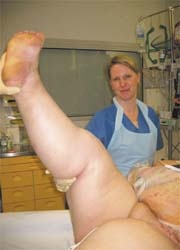Fat compromises surgical and intensive care patients
Professor confirms there are few or no solutions to most problems
Nutrition-induced obesity is a physical and budgetary problem. For example, in Germany alone, an estimated €20 billion has been spent on obesity related health problems.

According to a recent US-study, among 1,373 post-surgical intensive care patients, 33.3% with a BMI above 40, died, whereas mortality among average-weight patients was just 12.3 %. Published in 2004, a French study showed similar results.
‘After major surgical interventions obese patients often experience complications,’ confirmed Professor Elke Muhl MD, chair of the CAIN – working group on intensive and emergency medicine (Chirurgische Arbeitsgemeinschaft Intensiv- und Notfallmedizin) in Lübeck. ‘They range from pressure sores and wound healing problems to thrombosis and pneumonia, down to organ failure.’
- Many scanners, beds, operating tables etc. are too small to accommodate obese patients
- Surgical procedures are technically more demanding, needing more staff
- Special instruments and devices, operating tables and positioning aids must be adapted
- In traditional surgery larger incisions need to be made to gain a clear overview of the surgical site.
- In some cases, minimally invasive surgery (MIS) is out of the question.
- Postoperative care is more complex; for example, every second obese patient suffers hypertension (three times more than the average-weight population).
- 80% of all diabetes patients are obese. Disorders of the lipometabolism are also more prevalent in obese people, as are arterial stenoses. Diabetes and hypertension often lead to increased arteriosclerosis, which means the circulation, in particular the microcirculation in tissue is poor, which in turn impedes wound healing.
- Obese patients require longer injection needles and specially designed cannulas.
- To ensure their own health and safety, nurses need motor-driven beds and chairs for these patients. (‘Back-friendly’ methods, such as kinesthetics, can help with lifting approaches).
- Because many pharmaceutical companies lack data on dosage for the obese patient, determining medication dosage for obese patients could present a further problem.
‘Severe overweight is an increasing problem in surgery and intensive medicine,’ Professor Muhl agreed. ‘And we’ve not yet found satisfactory solutions for each problem.’
26.06.2007







